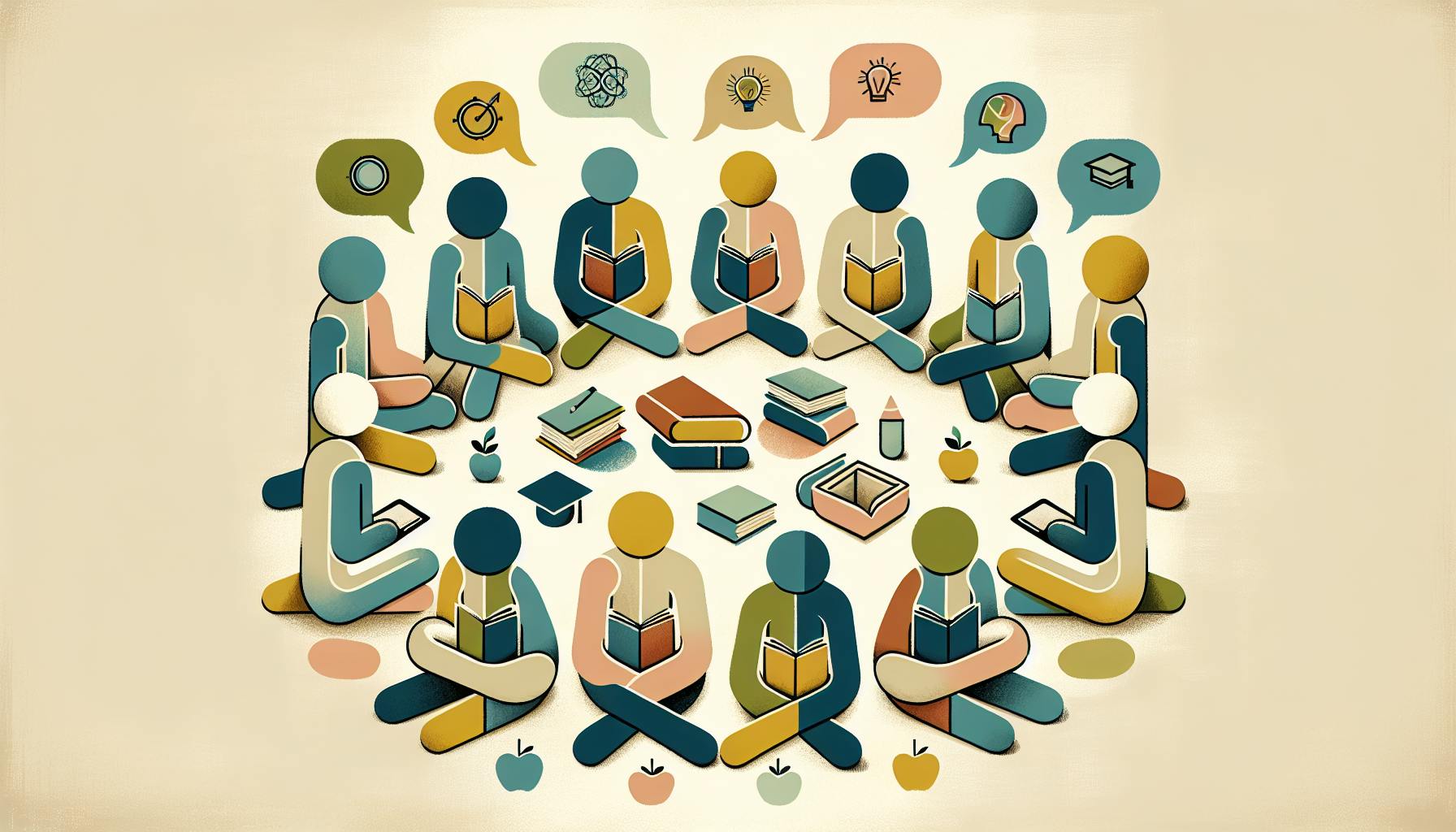As a new teacher, creating an organized, engaging classroom is an overwhelming challenge.
But having a toolbox of proven techniques for classroom management will set you up for success in managing student behavior, building relationships, and creating a positive learning environment.
This comprehensive guide outlines classroom management fundamentals across 5 key areas: establishing routines, promoting engagement, maintaining discipline, building relationships, and continuously improving. You'll discover specific strategies within each area to effectively manage your classroom.
Introduction to Classroom Management for New Teachers
Classroom management is essential for new teachers to create an effective learning environment. By establishing procedures, engaging students, and building relationships, teachers can foster a positive classroom culture.
Understanding the 5 Components of Classroom Management
The key elements that contribute to classroom management include:
- Classroom procedures and routines - Consistent processes for transitions, turning in work, using the bathroom, etc.
- Behavior expectations - Clear guidelines for student conduct communicated through rules and modeling.
- Engagement strategies - Methods to captivate student interest and participation.
- Teacher-student relationships - Getting to know students personally makes management easier.
- Classroom layout and organization - Thoughtful seating arrangements, decor, and storage solutions.
Classroom Management Skills for First-Year Teachers
Critical skills new teachers should focus on developing include:
- Setting clear expectations and rules from day one
- Being consistent in enforcing policies
- Building rapport with students through one-on-one conversations
- Planning interactive lessons that keep students stimulated
- Organizing the classroom layout strategically
Practicing these methods early on will lead to an orderly environment.
Overcoming Challenges: Struggling with Classroom Management
Common struggles and solutions include:
- Excessive disruptions - Reinforce rules, use proximity control, have a card flip warning system.
- Talking out of turn - Institute hand raising, anonymous paper ball system, rewards.
- Inattentiveness - Try varied activities, movement breaks, random student questioning.
- Disorganization - Simplify procedures, allow transition time, use checklist posters.
New teachers shouldn't get discouraged. Consistency and community building will improve issues over time.
The Role of Classroom Management Tools
Tools that can help streamline management:
- Seating charts - Memorize names faster.
- Timers - Keep students on track.
- Positive reinforcement systems - Motivate good behavior.
- Digital platforms - Record conduct, communicate with parents.
Integrating technology and tools tailored to your needs can simplify classroom administration.
Building a Positive Classroom Culture
Cultivating an encouraging environment leads to:
- Greater mutual understanding between teacher and students
- Students taking more responsibility and leadership
- More student engagement and enjoyment of learning
- Enhanced teacher job satisfaction
Displaying student work, recognizing achievements, using inclusive language, and leading by example are small ways to influence classroom culture for the better.
How can a new teacher manage a classroom?
As a new teacher, establishing effective classroom management can be challenging. Here are some practical tips to help you take control of your classroom:
Set Clear Expectations and Rules
- Develop 3-5 simple, positive rules for student behavior. Involve students in creating classroom rules to increase buy-in.
- Post rules prominently and refer back to them often. Review periodically.
- Establish routines and procedures for daily activities. Practice them.
Build Positive Relationships
- Learn student names quickly and show interest in them as individuals.
- Communicate respectfully. Listen attentively.
- Recognize good behavior more than criticizing bad. Praise students often.
Be Proactive About Engagement
- Captivate students right away with an interesting lesson opener.
- Use variety - alternate short lectures with discussions, activities, videos.
- Check for understanding frequently. Ask open-ended questions.
Respond Quickly to Misbehavior
- React calmly and consistently to disruptions. Avoid yelling or overreacting.
- Use non-verbal signals like eye contact or proximity to curb minor issues.
- Follow through with fair, logical consequences for continued misbehavior.
Consistency, confidence, and connection are key to successfully managing student behavior. Reflect on what works and continue fine-tuning your approach. With time and practice, classroom management will feel more intuitive. Reach out to mentors when you need advice or support.
What are the 5 P's of classroom management?
Classroom management can seem overwhelming for new teachers. However, following the 5 P's can help create an organized, productive environment where students can thrive.
Prompt
- Be punctual in starting and ending class. This demonstrates respect for students' time.
- Greet students at the door with a smile. This sets a positive tone.
- Use timers to keep activities moving. This maintains engagement.
Prepared
- Have lessons planned out in detail. This prevents wasted time.
- Prepare materials beforehand. This allows class to flow smoothly.
- Have backup plans ready. This handles unexpected issues gracefully.
Productive
- Structure activities for maximum student participation. This focuses energy on learning.
- Use small groups and stations. This gives students ownership.
- Assign roles for group work. This builds accountability.
Polite
- Model respectful language and behavior. This promotes positivity.
- Display classroom rules and reinforce them consistently. This maintains harmony.
- Use positive narration to correct issues. This gives students direction.
Position
- Circulate to scan student work and behavior. This supports success.
- Stand near potential problem areas. This deters misbehavior.
- Avoid staying static. This keeps all students on task.
Following these 5 P's builds the foundation for an engaging classroom where students can learn and grow. With consistency, they become second nature and make teaching rewarding.
What are the five techniques for effective classroom management?
Effective classroom management relies on implementing structures, procedures, and relationships that facilitate student learning. Here are five key techniques new teachers should focus on:
Set Clear Expectations and Rules
- Outline 3-5 simple rules/expectations (e.g. be respectful, be prepared)
- Explain what meeting expectations looks like
- Be consistent in enforcing expectations
Build Rapport and Relationships
- Learn student names quickly
- Show interest in students’ lives and interests
- Use positive reinforcement and encouragement
Establish Classroom Procedures and Routines
- Set procedures for common tasks (entering class, turning in work)
- Practice routines until they become habit
- Use visual reminders as needed
Plan Engaging Lessons
- Vary activities to maintain student interest
- Include opportunities for movement and collaboration
- Relate content to real-world examples
Be Proactive About Behavior Issues
- Redirect minor issues before they escalate
- Have a discipline plan for larger issues
- Involve parents as needed
Focusing on these fundamentals allows teachers to spend less time on discipline and more time on meaningful instruction. Maintaining an organized, supportive environment is essential for new teachers to thrive.
What are the 4 C's of classroom management?
Effective classroom management requires focusing on 4 key areas, known as the "Four C's":
Communication
- Clearly communicate classroom rules, expectations, and consequences to students
- Provide positive feedback and reinforcement
- Listen to students' needs and concerns
Collaboration
- Encourage students to work together
- Use group projects and peer learning opportunities
- Promote a community environment
Critical Thinking
- Ask open-ended questions
- Assign projects that develop problem-solving skills
- Teach students to evaluate information and think independently
Creativity
- Incorporate hands-on activities
- Allow students to express themselves
- Provide assignments with multiple solutions
By developing lessons and activities around the Four C's, teachers can promote student engagement, build a positive classroom culture, and take a student-centered approach to learning. This allows students to develop essential life skills while also meeting core curriculum standards.
sbb-itb-bb2be89
Establishing Classroom Routines and Procedures
As a new teacher, setting clear expectations and routines for classroom activities is crucial for keeping students focused and on-task. Here are some tips:
Designing Effective Classroom Rules
- Involve students in creating 3-5 simple, positive rules, such as "Be respectful", "Come prepared", and "Follow directions".
- Post the rules prominently and refer to them often when giving praise or reminders.
- Be consistent in enforcing the rules every day.
Managing Daily Transitions Efficiently
- Teach specific procedures for arrivals, dismissals, switching tasks, using materials, etc.
- Practice each routine multiple times. Use consistent signals like chimes, hand claps, or countdowns.
- Have students self-monitor and use positive reinforcement.
Facilitating Group Work and Student-Centered Learning
- Provide clear objectives, roles, and expectations for collaboration.
- Use techniques like think-pair-share to keep groups on topic.
- Have students reflect on teamwork skills and give peer feedback.
Enabling Independent Work through Classroom Organization
- Create stations with materials needed for specific tasks.
- Set up procedures for getting help, using bathroom passes, etc.
- Use proximity and nonverbal cues to refocus off-task behavior.
Integrating Educational Technology into Daily Routines
- Use apps for check-ins, exit tickets, classroom management.
- Set expectations for responsible use of devices.
- Build in tech breaks and movement breaks between tasks.
Establishing solid routines and procedures early on leads to increased student responsibility and focus, making classroom management much easier for new teachers.
Promoting Student Engagement and Effective Teaching Practices
Planning Interactive Lessons for Diverse Learners
To engage diverse learners, it's important to plan lessons that incorporate different teaching methods. Here are some tips:
- Balance lectures with discussions, small group work, and hands-on activities to appeal to different learning styles. Get students out of their seats and actively participating.
- Vary the types of assignments and assessments you use. Include projects, presentations, experiments, debates, journals, and more to tap into students' different strengths and interests.
- Provide choice in assignments when possible so students can showcase their talents. For example, let them pick a topic to research or select between project options.
- Use scaffolding techniques to meet students at their level while still challenging them. Break complex tasks into smaller, more manageable pieces.
- Plan moments for movement and brain breaks to re-energize students. Use short videos, games, physical challenges, and more.
Leveraging Educational Technology for Engagement
Educational technology tools can make lessons more engaging for today's tech-savvy students. Consider incorporating:
- Interactive online games, quizzes, and activities related to lesson content. These provide instant feedback to boost motivation.
- Multimedia like videos, animations, and slideshows to present material in a stimulating, multi-sensory way.
- Tools like Padlet and Kahoot for real-time collaboration, discussions, and friendly competition.
- Virtual simulations, augmented reality, and 3D models to immerse students in experiences impossible to recreate in the classroom.
- Communication tools like chat groups and discussion boards so learning can continue outside of class time.
Providing Differentiated Instruction to Meet Individual Needs
It's crucial to differentiate instruction to accommodate different learning styles and needs:
- Get to know students' strengths, weaknesses, interests, and motivations through assessments, observations, and conversations. Adjust teaching methods accordingly.
- Allow flexible pacing so students can work at an optimal speed. Have enrichment activities ready for quick learners and extra guidance for those needing more support.
- Vary instructional strategies - auditory, visual, kinesthetic - and provide physical learning aids like manipulatives for hands-on participation.
- Customize difficulty levels by offering leveled reading materials, tiered assignments with multiple entry points, and tailored writing prompts matching students' skills.
Fostering a Student-Centered Learning Environment
Student-centered learning shifts the focus from the teacher to students. Useful techniques include:
- Allowing students to take ownership of their learning by choosing paper topics, leading parts of a lesson, tracking their own progress, and setting academic goals.
- Grouping students heterogeneously and facilitating peer tutoring so they can learn collaboratively.
- Promoting inquiry through open-ended questions and challenges without defined solutions, allowing students to take creative risks.
- Connecting material to students' personal experiences and cultures so they feel represented in curricula and can apply skills meaningfully.
- Designing lessons focused on developing transferable life skills like communication, collaboration, critical thinking, and creativity.
Creating a Classroom Community through Inclusive Practices
Fostering an inclusive classroom community requires:
- Establishing shared values like respect, compassion, integrity, responsibility, and perseverance. Reinforce these in your language and policies.
- Promoting positive peer relationships through icebreakers, team building activities, peer feedback sessions, and class discussions.
- Displaying student work to showcase diversity of talents and make each student feel valued.
- Implementing cooperative learning structures where students support each other's growth by design.
- Cultivating cultural competence by learning about students' backgrounds and imparting multicultural wisdom.
Maintaining Classroom Discipline and a Learning Environment
As a new teacher, establishing and enforcing classroom rules and procedures is essential for maintaining discipline and a productive learning environment. Here are some best practices:
Employing Behavior Management Techniques
- Use incentive programs like rewards or recognition to motivate positive behavior. This reinforces good conduct.
- Employ public corrections for minor issues by briefly stating the infraction followed by the expected behavior. For more serious or repetitive issues, have private conversations.
- Consistently apply consequences for broken rules. Follow through each time with predetermined penalties like loss of privileges or detention.
De-escalating Challenging Situations with Calm Authority
- Speak calmly and listen when tensions arise. Seek to understand the student's perspective.
- Address the issue privately when possible. Avoid power struggles in front of classmates.
- Remain the authority figure and set logical consequences, not punishments. Require an apology or reflective essay.
Following Through on Consequences with Fairness
- Determine rules, rewards, and penalties clearly at the start of the term. Write them visibly in the classroom.
- When an infraction occurs, issue the predetermined consequence consistently, no matter the student.
- Document incidents thoroughly should you need to involve parents or administrators.
Ensuring a Safe and Respectful Learning Environment
- Cultivate mutual respect through modeling, class discussions, and zero tolerance for bullying.
- Be approachable. Build rapport and trust by getting to know students as individuals.
- Keep the classroom orderly and clean. Have established locations to store materials, backpacks, etc.
Professional Development for Teachers in Classroom Management
- Read books and articles or take seminars on best practices in student behavior management.
- Observe colleagues with effective classroom management skills and ask for mentoring.
- Evaluate your existing rules and procedures. Adjust ones that aren't working. Reflect on diffusing tense situations.
Building Teacher-Student Relationships and Teacher Well-being
Developing Rapport with Students
Building rapport with students is crucial for effective classroom management and student success. Take time at the start of the year to get to know your students' interests, learning styles, and backgrounds. Maintain an open dialogue and make each student feel valued. Simple practices like greeting students at the door, learning names quickly, and showing interest in their lives can go a long way.
Creating a Supportive Atmosphere for All Students
Foster an inclusive environment where every student feels safe, respected, and cared for. Be approachable and understanding, providing extra assistance when needed. Promote mutual respect between all students and do not tolerate bullying. Celebrate diversity and help students appreciate differences. A supportive, collaborative atmosphere enables all students to thrive.
Teacher Well-being and Self-Care Strategies
Avoid burnout by setting boundaries and taking care of your own needs. Block off prep time, take regular breaks, and maintain hobbies and relationships outside work. Seek mentors, attend workshops, or join support groups to exchange ideas. Keep perspective by reflecting on the positive impacts you have on students' lives. A healthy, balanced teacher is best equipped to manage a classroom effectively.
Reflecting on Practice for Continuous Improvement
Continuously self-assess and refine your approach, soliciting student feedback when possible. Observe veteran teachers’ methods and attend seminars on the latest research. Experiment with new techniques like personalized learning plans or student-led activities. Adjust rules and procedures that prove ineffective. Strive to improve at classroom relationships and time management. Reflection and adaptation leads to better student outcomes.
Conclusion: Synthesizing Classroom Management Strategies for New Teachers
By focusing on building strong foundations early and continuously refining their approaches over time, new teachers can create positive, productive classroom environments.
Key Takeaways in First-Year Classroom Management
In that critical first year, teachers should prioritize:
- Establishing clear expectations and procedures
- Building strong student-teacher relationships
- Promoting active student engagement
- Enforcing rules respectfully and consistently
When starting out, focusing on these core areas provides a solid framework for effective classroom management.
The Journey Ahead: Lifelong Learning in Classroom Management
Managing a classroom is a complex, evolving skillset. As teachers gain more experience, they can continue enhancing their methods by:
- Reflecting on what works and what doesn't
- Seeking out professional development opportunities
- Learning classroom management best practices
- Collaborating with fellow teachers
With an openness to lifelong learning, teachers can continually progress in this craft throughout their careers.


